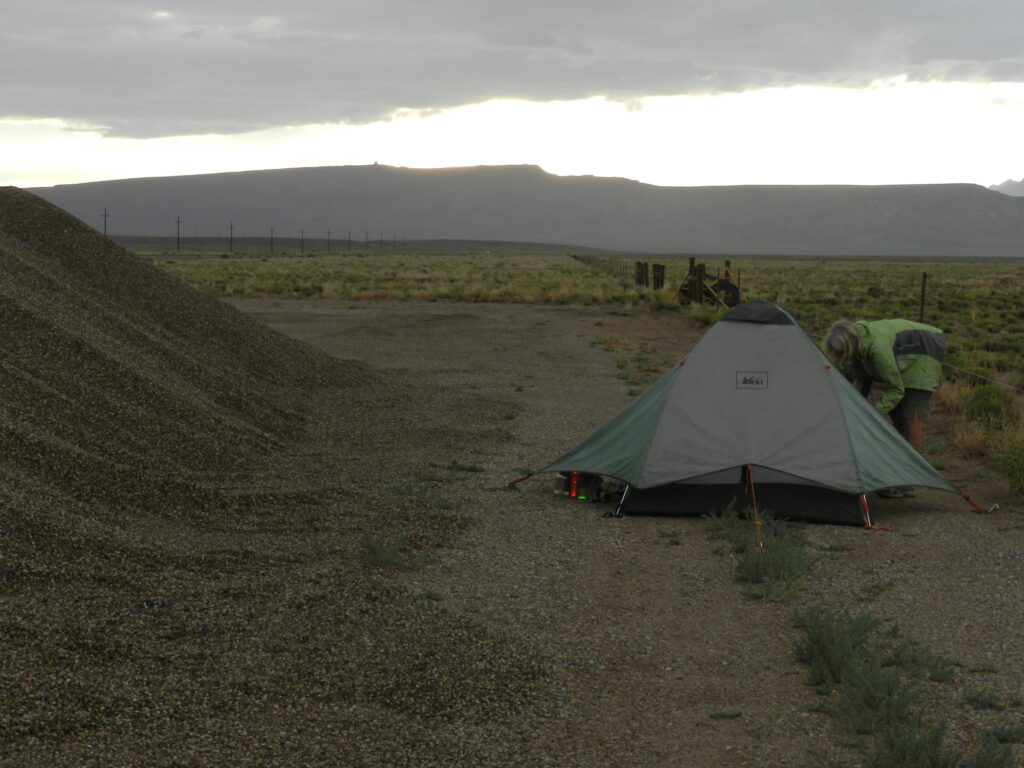As a long distance hiker you hear things about those who have hiked the trail before you. I knew that lack of water along the Nevada ADT occasionally forced hikers to take an alternate northern route along US 50 instead. We ended up taking an alternate route into Ely, Nevada as well, but ours was a southern detour caused by too much water.
On the third day of our seven day stretch heading out of Carvers, thunderstorms and my continued lethargy from bad water caused us to stop short at a backcountry campground, featuring the grand attraction of an outhouse to accommodate my frequent visits. The next day I felt better but more thunderstorms plus, um, backtracking from a wrong turn caused us to stop short again. More thunderstorms caused more setbacks, creating a dilemma.
I was scheduled to present my second talk to a Lions Club in Ely, Nevada. At our current pace I would miss that talk, with the possibility of more thunderstorms and obscure routes preventing us from arriving on time. Heading south to US 6 would add miles, but we would be able to make up ground quickly by walking a reliable route.
We passed an outhouse early in our detour. Though the outhouse was private I could not resist making a contribution, still afflicted by intestinal difficulties. The owner of the small ranch came by and, rather than scold us, invited us to lunch and to bathe in the hot springs on her property. We learned we were not the first ADT travelers she encountered, though personally I had not heard of anyone taking a southern detour before.
Our goal for the southern detour was US 6, which we would then follow into Ely. A watering trough for cattle awaited us there, allowing us to take a lunch break and fill up with water, knowing that this would be the last source until we reached Blackrock Station in the middle of the next day. Actually, we did encounter more water that afternoon, in the form of yet another thunderstorm.
At a turn out in the road, featuring a large gravel pile, we huddled with our packs under a groundcloth. After waiting out the storm for over an hour we made camp behind the gravel pile, the only feature in the open desert that could block our view from motorists. Not that we had much to worry about. When we hiked along US 50, the alleged loneliest highway, a vehicle would pass us about every 5-10 minutes. Along US 6 the gap was 15-20 minutes during the day and at night I doubt more than a handful of vehicles passed our “campsite.”

The next morning the lack of traffic became a problem. With Blackrock Station still a couple hours away we ran out of water. We could have hiked two hours without water even in the desert, but memories of heat exhaustion along the Pony Express Trail forbade me from risking that. Whenever I saw or heard the sound of a vehicle I held up a water bottle as we continued hiking. Three vehicles passed us without stopping, then I figured that my gesture might have been mistaken for a sort of “toast.” I instead held the water bottle upside down with the lid open and the next vehicle stopped to give us water.
Blackrock Station on US 6 was a far cry from Middlegate Station on US 50. At one time the Blackrock Station provided gas and supplies to motorists traveling between Tonopah and Ely, but now the one building there was a single family residence for the owners. Fortunately, they were home and provided us with water and snacks. I also used their landline to call Ky and tell her that Blackrock Station was our new rendezvous point. During our seven day stretch Ky had returned to California to spend time with her sister. We camped on nearby BLM property that evening.
We slackpacked the 75 miles from Blackrock Station to Ely in three days, with Ky meeting us along the way. After a couple days without thunderstorms the occasional puddle greeted us along the side of the road, though midafternoon temperatures surpassed 100 degrees. Thankfully, when a thunderstorm did occur we now were able to wait it out in Ky’s camper.
As each vehicle that passed us was miles away from the next vehicle, we got a good sense of which drivers were friendliest to vagabonds on the (real) loneliest highway. All truckers gave us a wide berth, which usually was sufficient to avoid blowing off our caps with their draft, and honked their horns in friendly greeting. Motorcyclists were the next friendliest. Cars and pick up trucks seemed not to even notice us and sometimes tested our nerves.
My Lions Club contact in Ely was also the high school principal and allowed us access to the school during our rest days there. We “camped” in the school foyer but could use the showers and other school property during a window of hours. The talk went well but, as was often the case, I learned as well as presented. I learned about Ely that a former boom and bust mining town revived itself by diversifying its economy. After witnessing the devastating effects of boom and bust economies across the state I retained this lesson on the importance of diversification in my memory banks.
Nothing noteworthy about Cindy occurred during this stretch. I continued to set up the tent, cooked the meals and recalled each day’s events for her journal. Fortunately, she was able to use the showers at the school without my assistance.
